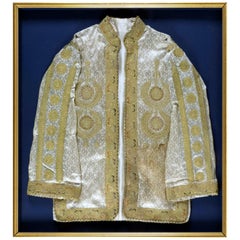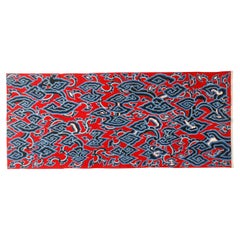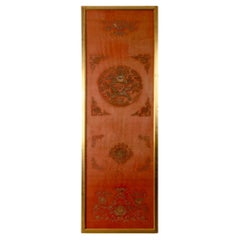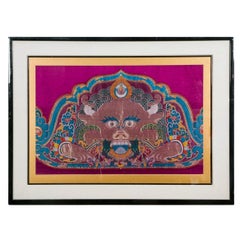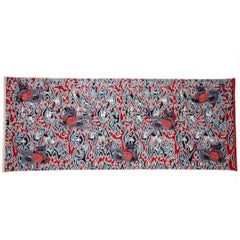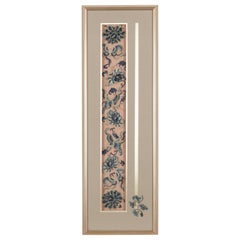Georgia - Textiles
to
5
139
1,223
371
139
1
3
86
50
34
10
1
4
2
1
138
108
61
17
17
139
131
75
48
6
139
139
139
Item Ships From: Georgia
Framed Ottoman Coat with Metallic Thread Embroidery
Located in Atlanta, GA
An lavishly decorated Turkish coat likely from the Ottoman Empire period circa 19th century, presented in a shadow box gilt frame with dark blue fabric lining. The jacket was made fr...
Category
19th Century Turkish Islamic Antique Georgia - Textiles
Materials
Brocade, Silk, Wood
Vintage Cloud Design Batik from Java Indonesia
Located in Atlanta, GA
Probably one of the most beautiful batik textile designs from Indonesia, the wraparound skirt also known as Kain Panjang was an iconic design from Cirebon, North Coast of Java. The Cloud design...
Category
Mid-20th Century Indonesian Tribal Georgia - Textiles
Materials
Textile
Chinese Silk Embroidered Chair Cover, 19th Century
Located in Savannah, GA
A Chinese silk embroidered chair cover, 19th century.
frame: 21 ¾ by 64 ¼ inches
Category
19th Century Chinese Antique Georgia - Textiles
Materials
Silk, Glass, Wood
Framed Tibetan Woven Silk Kesi Panel of Kirtimukha
Located in Atlanta, GA
A woven silk Kesi panel depicts Kirtimukha from Tibet circa the second half of 20th century. Beautifully woven from short weft silk with superb coloring and ...
Category
20th Century Tibetan Tibetan Georgia - Textiles
Materials
Silk
Splendid Vintage Cloud Design Batik from Java Indonesia
Located in Atlanta, GA
Probably one of the most beautiful batik textile designs from Indonesia, the wraparound skirt also known as Kain Panjang was an iconic design from Cirebon, North Coast of Java. The Cloud design...
Category
1950s Indonesian Tribal Vintage Georgia - Textiles
Materials
Textile
Framed Antique Chinese Embroidery Panel Qing Dynasty Provenance
Located in Atlanta, GA
An antique Chinese embroidery panel, originally the sleeve band of a robe from Qing Dynasty, circa 19th century. Nicely presented as a...
Category
Mid-19th Century Chinese Chinese Export Antique Georgia - Textiles
Materials
Silk, Wood
Antique Turkoman Yomut Bag Face Textile Wall Hanging
Located in Savannah, GA
Late 19th century Turkoman Yomut hand-knotted bag face.
A bag face is the front panel of a bag woven by various nomadic tribes of the Middle East and Central Asia for utilitarian and...
Category
1890s Turkmen Tribal Antique Georgia - Textiles
Materials
Wool
$1,580 Sale Price
32% Off
Japanese Fireman Hood with Stencil Inscription Meiji Period
Located in Atlanta, GA
A well-preserved Japanese fireman's hood (known as hikeshi zukin in Japanese) circa 1900s, late Meiji period. Woven with thick cotton with sashiko (co...
Category
Early 1900s Japanese Japonisme Antique Georgia - Textiles
Materials
Cotton
Pair of Framed Chinese Embroidered Ninth Rank Badges Qing Dynasty
Located in Atlanta, GA
On offer is a matching pair of embroidered silk civil rank badge panels (known in Chinese as Buzi) in black lacquer frames. The panels feature a black background within a scrolling floral border. In the center, it showcases a winged paradise fly catcher...
Category
Late 19th Century Chinese Chinoiserie Antique Georgia - Textiles
Materials
Silk, Giltwood
Framed Antique Japanese Embroidery Fukusa Panel
Located in Atlanta, GA
A finely embroidered Japanese silk Fukusa panel presented in a beautiful brocade-wrapped fame. Circa late 19th century of Meiji Period, Fukusa is a traditional Japanese textile...
Category
Late 19th Century Japanese Meiji Antique Georgia - Textiles
Materials
Silk, Wood
Japanese Indigo Kasuri Ikat Traveling Cape
Located in Atlanta, GA
Known in Japanese as Bozugappa (priest's raincoat), this cape-like garment was worn by the travelers in Japan circa late 19th century to early 20th century (end of Meiji period). Derived from the cape worn by the Portuguese missionary, who first arrived in Japan in mid-16th century, this type of cape was originally reserved for the Japanese military...
Category
1890s Japanese Meiji Antique Georgia - Textiles
Materials
Cotton, Linen
Ceremonial Cape Textile Art from Hmong Miao People
Located in Atlanta, GA
An oversized and impressive cape worn during ceremonial dancing by Miao people (also known as Hmong in English) from Guizhou Province, China circa 1940s-1950s in a rarely intact and well-preserved condition. Miao people are diverse minority groups living in Southern China as well as Southeast Asia with complex sub-affiliations based on attires, languages, cultural customs and art tradition. They are renowned for their textile and silver craftsmanship as well as singing and dancing traditions. This cape, rather heavy in construction and striking in bold red and black, was made from wool, hemp and cotton. The surface showcases elongated diamond patterns in complementary woven wool and couched plaque on top of the cotton part. The pattern strikes the viewer with a strong sense of dignity and power. The heavy material and pattern are strangely akin to some of the Navajo weaving. The cape is in a form a jacket with long and wide sleeves, and it was meant to be used in ceremonial occasions.
Our research reveals that the piece was from the Northwest Guizhou in an autonomous county called Weining. The area is of subtropical highland and the generally cold weather was reflected in the heavy materials used in this piece, in comparison with other textiles made in the warmer lowland.
There is an older paper label with price tag in Chinese inside the cape. It was purchased in Guizhou decades ago by a US collection in MA. With a span of over 94 inches long, it makes a very impressive textile art piece for wall hanging. Not framed and easily shipping folded up.
For a similar jacket from Weining, see "Miao Textile...
Category
Mid-20th Century Chinese Tribal Georgia - Textiles
Materials
Textile
Japanese Antique Fukusa Textile Art Meiji Period
Located in Atlanta, GA
A Japanese silk Fukusa panel circa late 19th-early 20th century of Meiji Period. The front was beautifully decorated with Yuzen-zome, a labor intensive resist-dye technique invested ...
Category
Early 20th Century Japanese Japonisme Georgia - Textiles
Materials
Silk, Beads
Framed Japanese Futon Cover Textile Art with Resist Yuzen Dye
Located in Atlanta, GA
A large piece of framed Japanese textile circa late 19th to early 20th century, end of Meiji period. Seamed together from four vertical sectio...
Category
Early 20th Century Japanese Meiji Georgia - Textiles
Materials
Cotton, Wood
Japanese Two-Piece Indigo Asa Kyogen Festival Costume Meiji Period
Located in Atlanta, GA
A two-piece Japanese festival costume based on Kyogen theater performance circa late 19th century (Meiji Period). The matching assemble consists of an oversize jacket (Suo) and a pai...
Category
Early 20th Century Japanese Meiji Georgia - Textiles
Materials
Linen
Set of Three-Framed Antique Chinese Textiles Qing Dynasty Provenance
Located in Atlanta, GA
A set of three antique textile fragments from China, circa 19th century Qing dynasty, professionally displayed in matching giltwood frames as a triptych. Originally they were embroidered panels from semi-formal skirt...
Category
Mid-19th Century Chinese Chinese Export Antique Georgia - Textiles
Materials
Silk, Giltwood
Framed Chinese Antique Brocade Dragon Panel
Located in Atlanta, GA
Antique Chinese brocade dragon panel from Imperial Qing Dynasty circa 19th century, beautifully presented with a linen mat and in a silvered wo...
Category
19th Century Chinese Chinese Export Antique Georgia - Textiles
Materials
Brocade, Silk, Wood
Two Framed Chinese Antique Textile Fragments Qing Dynasty Provenance
Located in Atlanta, GA
A group of two antique textile fragments from China, circa 19th century Qing dynasty, professionally preserved and displayed in giltwood frame...
Category
Mid-19th Century Chinese Chinese Export Antique Georgia - Textiles
Materials
Silk, Wood
Qing Dynasty Iris Roundel
Located in Atlanta, GA
Qing Dynasty embroidered silk roundel depicting a profusion of irises.
The flowers are embroidered in satin stitch in various shades of blue and ivory o...
Category
19th Century Chinese Antique Georgia - Textiles
Materials
Silk
